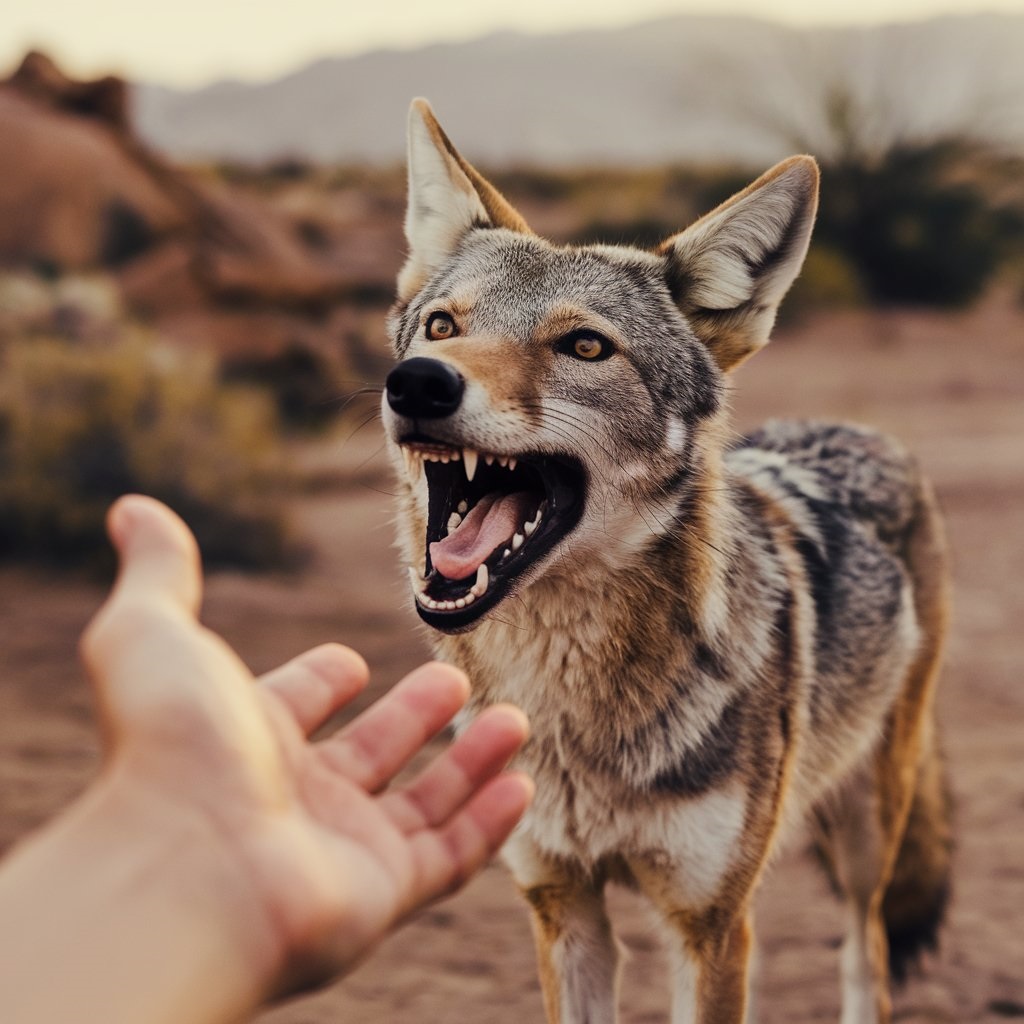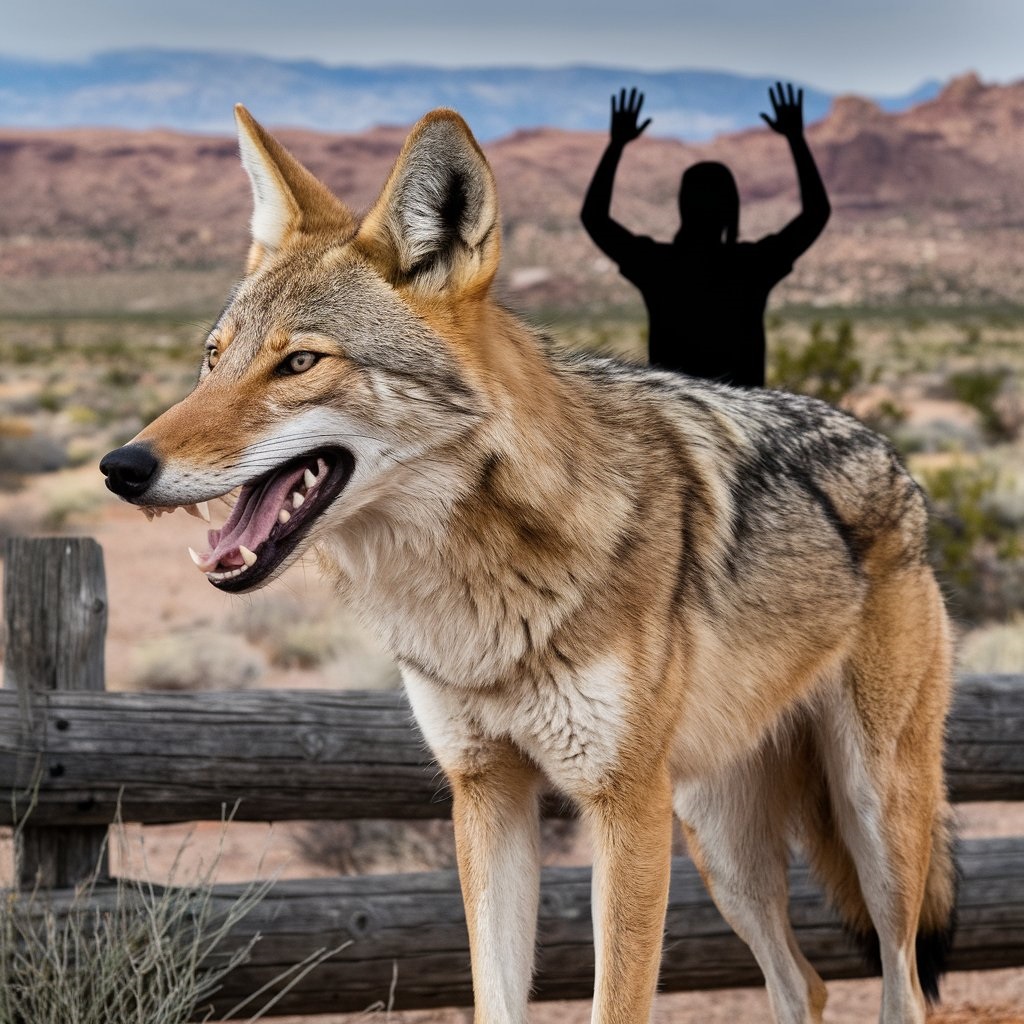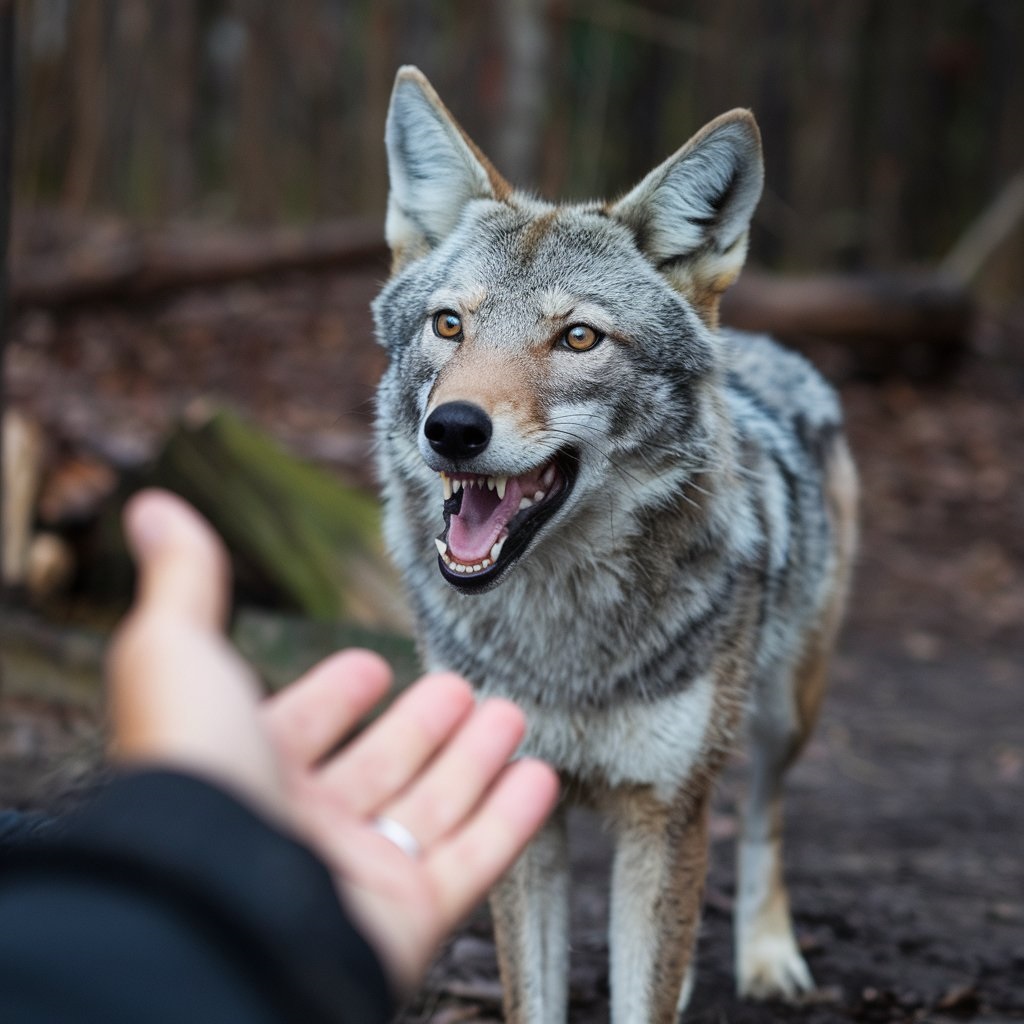Coyotes are often misunderstood, especially in urban areas where their presence is becoming more common. While many fear the idea of coyote attacks, the reality is far more nuanced. Do coyotes attack humans?
This question, often sparked by sensationalized stories and misconceptions, has a much deeper answer. In this comprehensive guide, we’ll explore coyote behavior, rare incidents involving attacks, the role of wildlife management, and the best ways to coexist with coyotes safely.
Here’s a table summarizing key facts and figures from the article:
| Topic | Fact/Figure |
|---|---|
| Coyote Size | Typically weigh between 24 and 46 pounds and stand 21 to 24 inches at the shoulder. |
| Coyote Diet | Primarily hunt small mammals like rabbits, rodents, and squirrels; also scavenge in urban areas. |
| Coyote Range | Found across much of North America, from rural areas to urban environments. |
| Coyote Lifespan | Typically live 6-8 years in the wild, though some may live longer in captivity. |
| Frequency of Attacks on Humans | Extremely rare; most coyotes avoid humans and do not pose a significant threat. |
| Rabies in Coyotes | Low prevalence of rabies in the coyote population, though infected coyotes may display aggressive behavior. |
| Coyote Population Growth | Coyotes have expanded significantly over the past century, now thriving in urban areas. |
| Notable Coyote Attacks | California (1981) and Nova Scotia (2009) are among the few notable coyote attacks on humans. |
| Best Practices for Prevention | Never feed coyotes, supervise pets, use hazing techniques, secure trash bins, install fences. |
| Urban Coyote Behavior | Coyotes in urban areas are typically nocturnal and opportunistic feeders, adapting well to city life. |
| Coyotes in Urban Areas | Urban coyotes are found in cities like Los Angeles, Chicago, and New York. |
| Coexistence Strategies | Educate the public, create wildlife corridors, secure food sources, and promote mutual respect. |
| Myth 1: Coyotes as Major Threats | Coyotes are not a significant threat to humans; attacks are rare and usually due to specific circumstances. |
| Myth 2: All Coyotes Carry Rabies | Not all coyotes are infected with rabies. The prevalence is low in healthy populations. |
| Myth 3: Coyotes Attack Pets Without Provocation | Attacks on pets are more likely when pets are unsupervised or vulnerable, not a common behavior. |
Who is the Coyote?
The coyote (Canis latrans) is a wild animal belonging to the dog family, closely related to wolves and foxes. Its adaptability is one of its most notable characteristics, allowing it to thrive in diverse environments from rural wilderness areas to bustling urban neighborhoods.

Physical Characteristics
Coyotes are relatively small compared to other wild predators. Here’s a breakdown of their size and physical traits:
- Weight: They typically weigh between 24 and 46 pounds, with males being slightly heavier than females.
- Height: Coyotes stand around 21 to 24 inches tall at the shoulder.
- Fur Color: Their coats are a mix of gray, brown, and tan, with a light-colored underbelly.
- Distinguishing Features: Coyotes have a long, narrow face, large upright ears, and a bushy tail.
Habitat and Range
Coyotes are found throughout North America, ranging from the western plains to urbanized areas in the East. Their range has expanded significantly, partly due to their ability to adapt to changing environments. Once confined to the wilds, coyotes have now adapted to living in cities, suburbs, and even residential backyards.
Behavior and Diet
Coyotes are opportunistic feeders, meaning they will eat whatever food is available, whether it’s small mammals like rabbits, rodents, or squirrels, or even human food sources like garbage. Their diet varies based on the environment. In rural settings, they rely on hunting small prey, while in urban settings, they may scavenge trash or feed on pet food left outside.
Do Coyotes Attack Humans?
The question “Do coyotes attack humans?” often arises when people hear about incidents involving these animals. While attacks are rare, it’s essential to understand the behaviors that lead to such encounters and how we can prevent them.
Understanding Coyote Behavior
Coyotes are generally shy and prefer to avoid humans. They are not naturally inclined to attack. Instead, they try to flee when faced with a human. However, certain situations can lead to aggression:
- Territorial Defense: Coyotes can become aggressive if they feel their territory is being threatened. This is particularly true during their mating season or when they have young pups to protect.
- Habituation: Coyotes that have become accustomed to human presence are more likely to lose their natural fear and may view humans as potential food sources.
- Rabies or Illness: A rabid coyote or one suffering from an illness can display aggressive behavior, which may lead to an attack.
Why Coyotes Rarely Attack Humans
The fear of coyotes often comes from a misunderstanding of their true behavior. Coyotes are generally non-aggressive toward humans. They are opportunistic feeders, meaning that while they may see pets or garbage as easy food sources, they do not typically hunt humans. Coyotes have been living alongside humans for centuries, and only a small fraction of them will ever pose a threat.

Are Coyotes Dangerous to Humans?
Coyotes are wild animals, and as with any wild animal, there’s always a potential for danger. However, the risk of coyote attacks on humans is very low. These animals are not predators of humans but prefer to avoid us whenever possible.
Key Risk Factors
Several factors contribute to why a coyote might attack or display aggressive behavior:
- Habituation to Humans: In areas where coyotes are regularly fed by humans (either intentionally or unintentionally), they may lose their natural fear. This can lead to bolder behavior, including approaching people and pets.
- Rabies or Disease: Rabid coyotes are a genuine concern, as they can exhibit erratic behavior. Rabies is a viral disease that affects the central nervous system, leading to aggression and disorientation. However, the number of coyotes infected with rabies is very small.
- Food Scarcity: Coyotes in areas where their natural food sources are scarce may become more desperate. This can sometimes cause them to act aggressively in search of food, including hunting small pets.
Are They More Dangerous Than Other Predators?
Compared to larger predators like wolves or mountain lions, coyotes are not nearly as dangerous to humans. While they can pose a threat to pets, particularly smaller animals, coyotes are much less likely to attack humans. Their natural behavior is to avoid confrontation, and most attacks occur in very specific circumstances.
Coyote Attacks on Humans: Rare but Possible
While coyote attacks on humans are rare, they do occasionally happen. It’s essential to understand the circumstances that lead to such incidents, as well as the steps you can take to reduce your risk.
Notable Incidents
Though rare, there have been instances where coyotes attacked humans. Here are a few high-profile cases that have brought attention to the issue:
- 1981 California Attack: A child in California was attacked by a coyote that had grown accustomed to humans. The coyote was later captured and euthanized. This was one of the first widely publicized coyote attacks in the U.S.
- 2009 Nova Scotia Fatality: A woman was killed by a coyote while walking near her home in Nova Scotia. The coyote was later found to be rabid, which played a significant role in the attack.
Why Do Attacks Happen?
The main reasons behind coyote attacks on humans include:
- Habituation: Coyotes that are fed by humans or live in close proximity to them may lose their natural fear of people, leading to aggressive behavior.
- Territoriality: Coyotes may act aggressively to defend their territory, especially if they feel threatened by an unfamiliar presence.
- Rabies: Infected coyotes may lose their normal behavior and act out of character, leading to unpredictable and dangerous actions.
Preventing Coyote Attacks and Safety Measures
Even though the risk of an attack is low, it’s still important to take steps to protect yourself and your loved ones from potential encounters with coyotes. There are several prevention methods that can reduce the likelihood of an attack.

How to Prevent Coyote Encounters
Here are several proactive measures you can take to minimize the chances of a coyote encounter:
- Avoid Feeding Coyotes: Do not feed coyotes, whether intentionally or unintentionally. This includes leaving pet food outside or allowing trash to accumulate in your yard.
- Supervise Pets: Coyotes may attack small pets, particularly if they’re left unsupervised. Always supervise pets, especially at night, and keep them in a securely fenced area when outside.
- Use Hazing Techniques: If you encounter a coyote, make loud noises, throw small objects (not aimed to hurt), and make yourself appear larger. Coyotes are naturally afraid of humans and will often retreat when they feel threatened.
- Secure Garbage: Coyotes will often scavenge for food in trash cans. Make sure garbage is secured in a container that coyotes cannot access.
Coyote Hazing: A Simple Yet Effective Strategy
One of the best ways to discourage coyotes from approaching is through hazing. This involves using loud noises, waving your arms, or using a flashlight to make yourself appear larger and more intimidating. The goal is to reinforce the idea that humans are not a source of food and that coyotes should avoid us.
Coyotes in Urban Areas
As cities expand, so does the presence of coyotes. Many urban areas, such as Los Angeles, Chicago, and New York, now host healthy coyote populations. Their ability to adapt to urban settings and find food in places like parks, yards, and garbage bins has made them a regular feature of urban wildlife.
Why Coyotes Thrive in Cities
Urban areas offer several advantages to coyotes:
- Abundant Food Sources: Cities provide easy access to food, such as pet food, garbage, and small rodents that thrive in urban environments.
- Fewer Predators: In cities, coyotes face fewer natural predators compared to rural areas. This allows their populations to grow.
- Safe Denning Sites: Urban areas offer plenty of hiding spots for coyotes, from parks to wooded areas to abandoned buildings.
How Coyotes Behave in Urban Areas
Urban coyotes tend to be more nocturnal, avoiding human contact during the day. However, if they are habituated to human environments, they may become more active during daylight hours, particularly if they are foraging for food.
Living with Coyotes: Can We Coexist?
The key to living safely with coyotes is coexistence. While coyotes can be seen as a nuisance or a threat, they play an essential role in the ecosystem. Here are some strategies for peacefully coexisting with these adaptable animals.
The Benefits of Coyotes in Ecosystems
Coyotes are part of the natural predator-prey balance in ecosystems. They control populations of rodents and other small mammals, which can have a positive impact on local biodiversity. By keeping rodent numbers in check, coyotes help maintain the health of ecosystems and reduce the need for chemical pesticides.
How to Coexist with Coyotes
- Secure your home and yard: Eliminate food sources that attract coyotes.
- Educate the community: Raise awareness about coyotes and how to live alongside them safely.
- Promote wildlife corridors: Encourage the development of safe wildlife corridors to reduce human-wildlife conflict.
Coyote Myths and Misconceptions
Misunderstandings about coyotes contribute to unnecessary fear. Let’s clear up some of the most common myths.
“Coyotes are a Significant Threat to Humans”
While coyotes can be dangerous in rare instances, they are not a significant threat to humans. Most coyote attacks are defensive, and the risk to people remains low.
“All Coyotes Carry Rabies”
Not all coyotes carry rabies. While rabid coyotes can be dangerous, rabies is not widespread in coyote populations. The risk of encountering a rabid coyote is minimal.
“Coyotes Will Attack Your Pets Without Provocation”
Coyotes may prey on small pets, but this typically happens when pets are left unsupervised. Coyotes usually avoid larger animals and do not aggressively target pets unless food is scarce.

FAQs
How likely is a coyote to attack a human?
Coyote attacks on humans are rare but have been increasing, particularly in California, though serious injuries are uncommon.
What will a coyote do if it sees a human?
Coyotes are usually fearful of humans and will run away, but if they don’t, it’s important to make loud noises and appear larger to scare them off.
Can a coyote kill a pitbull?
A pack of coyotes can overpower and kill a pit bull, especially if it is left unsupervised or without proper fencing at night.
Are coyotes scared of humans?
Coyotes tend to be fearful of humans, and making loud noises or waving your arms can help deter them.
Can a human beat a coyote in a fight?
Given that some coyotes are small, it’s possible for a human to overpower them, but larger coyotes could pose a risk.
What is the biggest threat to coyotes?
Humans are the primary threat to coyotes, with hunting and trapping reducing their numbers and competition.
Will a coyote run at you?
Coyotes are typically wary of humans and will run away unless provoked or if they feel threatened.
Conclusion
Coyotes are not a significant threat to humans, and attacks are rare. By understanding their behavior, taking proactive safety measures, and learning to coexist, we can live safely with these fascinating animals. Coyotes play an important role in ecosystems, and with a bit of knowledge and respect, we can avoid conflict and appreciate their presence in urban and rural environments alike.
If you encounter a coyote or are concerned about safety, contact local wildlife management agencies or wildlife rehabilitation centers for guidance. Together, we can ensure that humans and coyotes can share the environment without conflict.
Read more knowledgeable blogs on Flowy Magazine

James Clair is a passionate writer and researcher with a deep fascination for animal behavior and its intricate connection to human life. With a background in [relevant field of study, e.g., zoology, psychology, ethology], James has spent years studying the natural world, focusing on how animals’ actions and instincts impact human emotions, behavior, and society.
His expertise in [specific topics or regions of focus, e.g., canine psychology, animal communication, wildlife conservation] has led to numerous published works and collaborations with renowned researchers and institutions. Through his work at Flawy Magazine, James aims to bridge the gap between scientific research and public understanding, offering insightful, accessible articles that explore the complex relationship between humans and animals.
When he’s not writing, James enjoys [personal hobbies or interests, e.g., hiking in nature, volunteering at animal shelters, photography] and is an advocate for [cause or charity related to animals or conservation]. His mission is to inspire readers to see animals not just as companions or creatures of the wild, but as beings whose behavior holds valuable lessons for us all.









